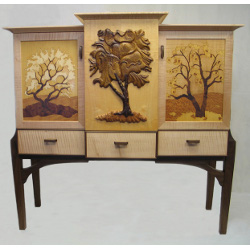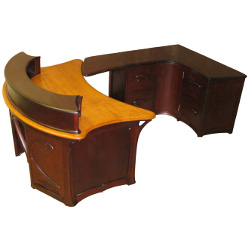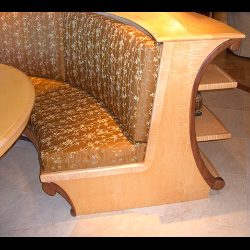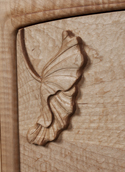

Please click on thumbnail to view details.

In the Spring of 2010, I received a phone call from a gentleman in San Francisco. He had seen my Art Nouveau desk on the internet, and wanted a variant of it for his own use.
We decided on 72" x44" dimensions for the parabolic desktop, which provided a practical working surface of 65" x 36". He chose cherry and walnut for the woods. This desk has two file drawers on one side, and a graduated set of drawers on the other. A pencil drawer was also added.
Although I often deliver furniture myself (especially to San Francisco), I was so overbooked at the time that I could not leave the shop. We built a crate for the desk and shipped it out from Boston, through a specialty carrier who normally serves the antique market. The desk arrived in perfect condition, and the client was ecstatic with his special delivery.
More images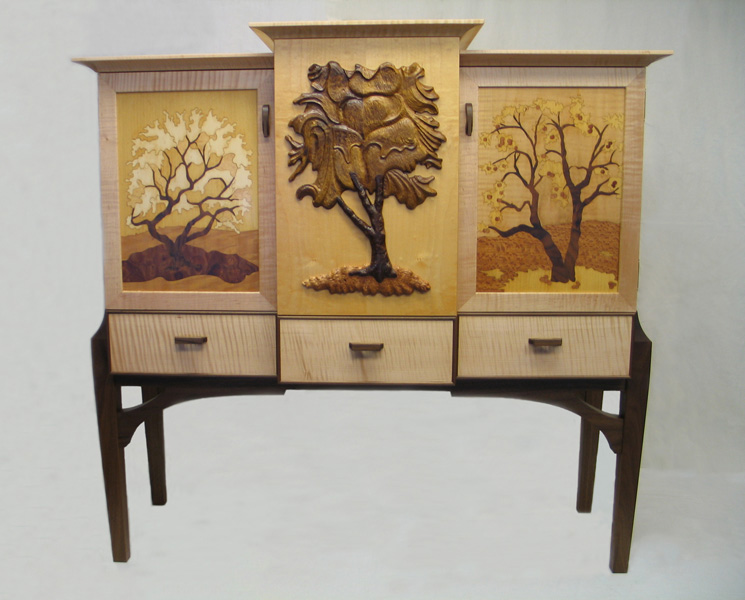
This curly maple and walnut cellaret was originally accepted for the 2012 Furniture Society invitational show in Portland, Maine. Unfortunately, it was not finished in time, but that allowed certain elements of the carving to evolve into their present configuration. The two side doors have marquetry panels representing apple trees in spring and fall, designed by Anne Long. I carved the apple tree in summer on the center panel of apple wood and walnut burl, and applied it to the solid maple case.
The cellaret has a lift top center cavity to hold wine and/or liquor bottles and mixers. It is attached with safety-lock hinges to the main case. The side compartments have movable shelves to house stemware, tumblers and other mixers or glasses. Three drawers are provided for wine and beer openers, stirrers, napkins and other necessities.
More images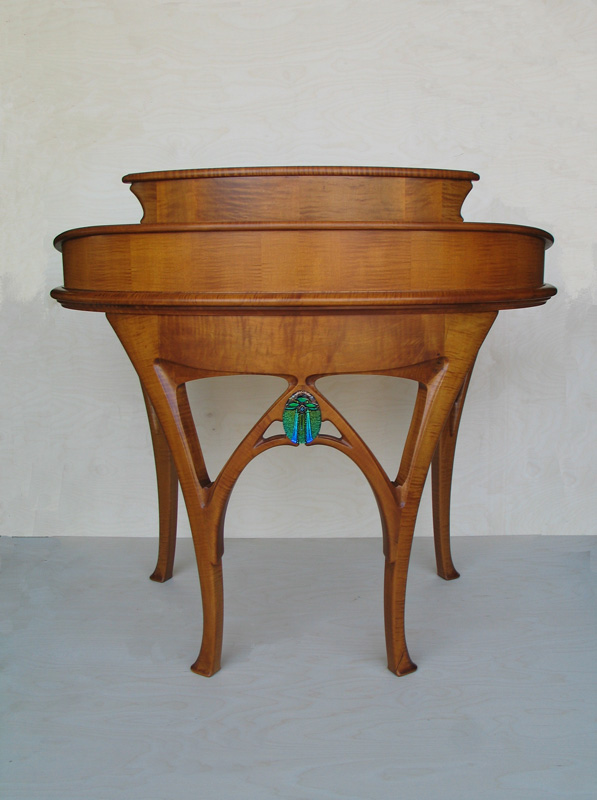
This Art-Nouveau inspired desk emerged as part of a client's desire for a working 'home' office environment for himself and his wife/partner. This particular desk was intended to serve as a 'laptop' station for his work as a designer/consultant. A creative writer saw this desk and instantly declared it 'inspirational'.
The desk itself was built from solid, hand-carved curly maple, with a curved, pigeonhole gallery built onto the primary working surface. The desk is delicate and has many exceptional hand-carved details, including the sloping gallery shelves. The desk faces outward, featuring a custom-made art glass scarab, with light reflective, fused diachronic elements embedded in the composition.
More images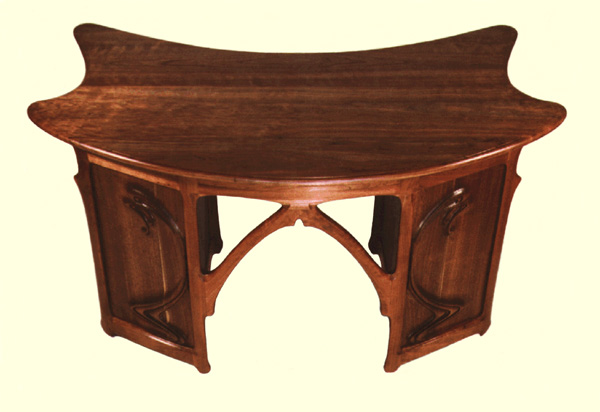
This 'Art Nouveau Desk' was originally designed and built on speculation between 1979-1980, and was sold shortly thereafter. It is representative of the fluid style of the art nouveau period (at its height between 1890-1905), and it demonstrates my continuous involvement with art nouveau over the length of my career.
The desk is curved and hand-carved on all of its four sides, and the top is a unique parabolic shape. This untraditional form was constructed with traditional techniques of solid cherry and walnut, with poplar wood on the drawer interiors. Although it was inspired by the work of the art nouveau period designer Hector Guimard, it is not a reproduction of any of his work.
More images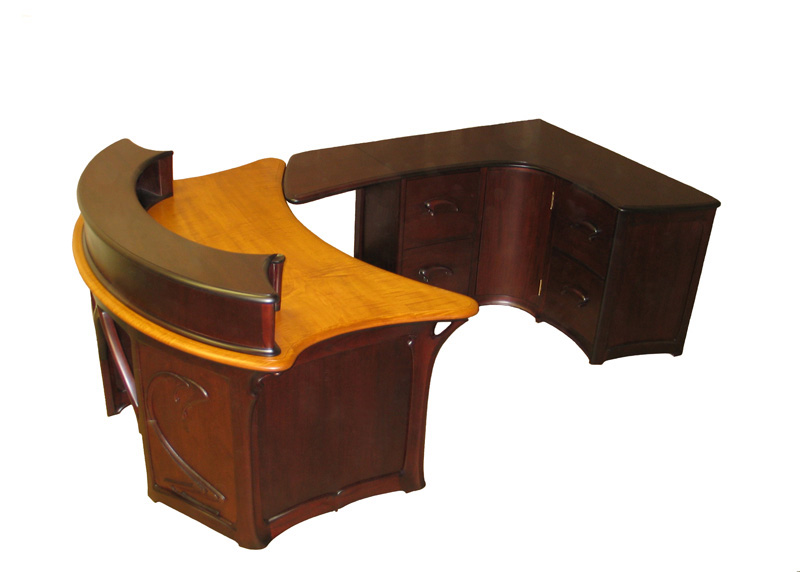
This is the most complex of the 'Art Nouveau' line of desks in this design. It includes the gallery component, as well as a matching, curved 'Back Desk' that serves as additional work- and storage space in an efficient, wrap-around design.
It is built from mahogany and curly maple woods, with a Hokusai-inspired wave carving in the front panels. The framing, brackets, door fronts and door handles of this desk are all hand-carved from sold wood. The desktop itself is in a unique, parabolic design in sold cherry, with curved wings and carved molding.
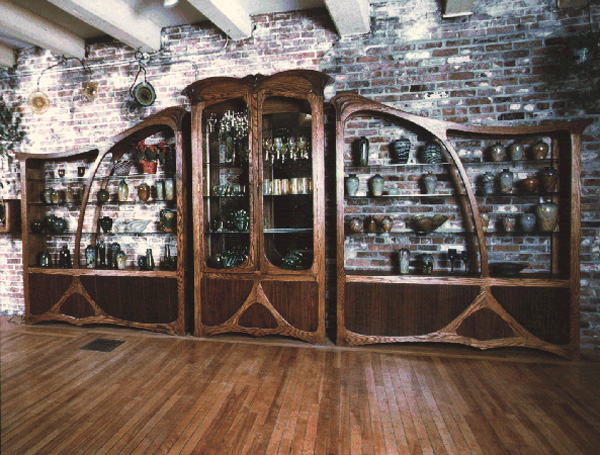
This trio of display cases was made as part of a suite for a retail facility specializing in hand-blown art glass and on-site glassblowing. Art glass was a singular expression of the Art Nouveau period, culminating in the work of Louis Comfort Tiffany and Emile Galle, among others. The sweeping curves of these Art Nouveau Display Cases pay homage to that tradition and that era.
The woods used in the cases include oak panels within hand-carved mahoghany stiles and rails that comprise the framing of the structure. We appreciate the opportunity to place our work in public or retail settings, and as a custom shop, we specialize in accommodating our client’s needs for commercial as well as residential environments.
More images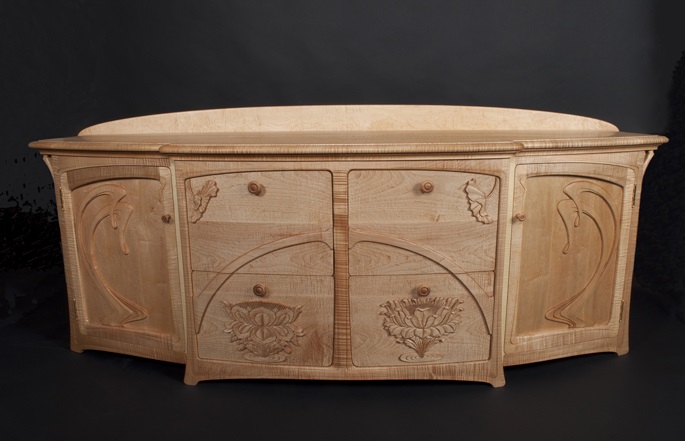
In 2008, I was contacted by a person expressing interest in my Art Nouveau furniture designs and we exchanged several detailed emails. She discussed her deep commitment to Buddhism, and indicated that she wanted furnishings that would be reflective of her spiritual life. Thereafter, I did not hear from her for almost a year.
Suddenly, she was ready to more forward with the ideas and imagery that we had explored during our first communications. At her request, I traveled to Montana to review specific Buddhist images and iconography that was to be incorporated into the fluid lines of art nouveau cases. A criterion of the project was that no toxic chemicals be used, and it would be of total “Leeds’ environmental standards. In all, seven pieces were needed, and everything was to be built of solid wood. She opted for the lightness and strength of curly maple.
This credenza is one of the pieces built for this client. While emulating a classic tripartite division of cabinets, it bows forward in a graceful, sweeping curve and then returns. The long curve of the top reflects this bow front, while the vertical supports fan out to the sides in similar delicate lines. The façade of credenza is slightly broken, with the two paneled doors of the central section projecting forward from the single panel sections on either side. All the doors incorporate hand carved panels within art nouveau carved framing, and open up to shelves and file drawers used in this singular office.
The lotus blossom is the central theme of this piece, and every panel has carved lotus flowers in various stages of openness. These blossoms are carved in high relief, which allows a play of light and shadow despite the single pale color of the entirety.
More images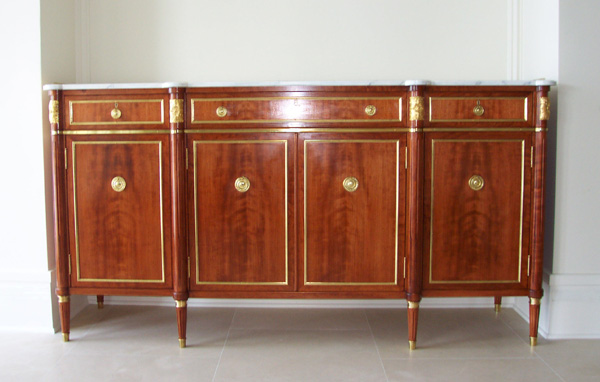
These exceptional sideboards are reproductions of an original credenza by renowned furniture maker Honore Lannuier, c. 1840. I was asked to reproduce this piece for clients who maintain an ongoing interest in American Federal Furniture. They had already commissioned a pedestal-base Regency dining table for their primary home, to match a set of period Chippendale chairs that they had acquired at great effort. Now, in their second home in Naples, Florida, they endeavored to continue their patronage and extend their resources for fine entertaining.
After commissioning another Regency pedestal base table and 12 Biedermeier style chairs for their Florida home, they decided to extend their patronage to a pair of matching crotch mahogany sideboards with detailed brass pulls and banding, and applied ormule decoration. Each sideboard has three sections, with frame and panel doors, two on center, flanked by a single section on each side. Each panel is framed by an inlaid brass line, as are the narrow drawers. Four fluted legs divide the façade, resting on custom brass feet with ormule crests on top, with a band of brass separating the upper drawers. The legs project forward from the plane of the case, and create a sculptural interplay of light and shadow on the facade, and an undulating line on the perimeter of the marble top.
This commission challenged me to create clay molds of period hardware and ormule, then locate metal workers who were able to match this level of craftsmanship.
More images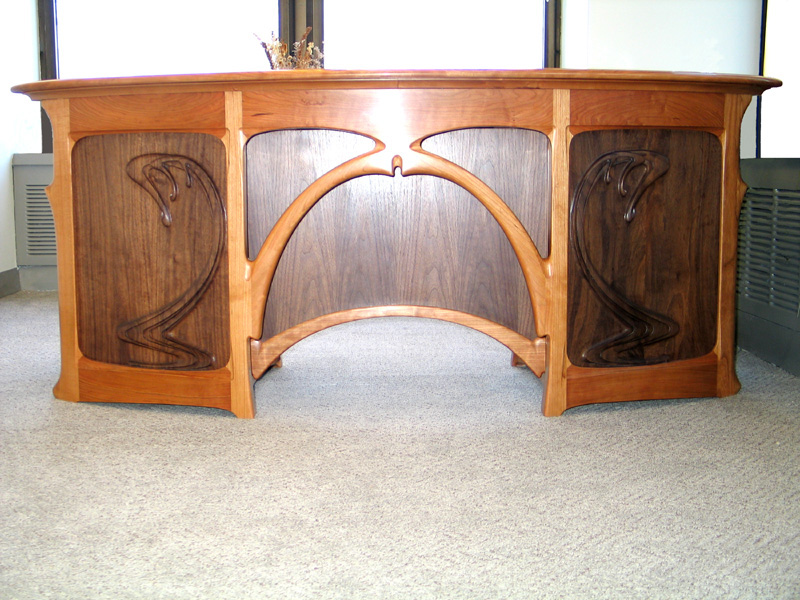
We have built a number of desks and office suites over the years, but our range of Art Nouveau Desks remain the most sought after. This variation is made of solid walnut and cherry, and is hand-carved. It also has a privacy screen in the kneehole. All variations of the Art Nouveau Desk are curved and hand-carved on all four sides, and the top is a unique parabolic shape.
My original 'Art Nouveau Desk', also seen on this website, was a smaller scale and was designed and built on speculation between 1979-1980. It is representative of the fluid style of the art nouveau period (at its height between 1890-1905), and it demonstrates my continuous involvement with art nouveau over the length of my career. Although this desk was inspired by the work of the art nouveau period designer Hector Guimard, it is not a reproduction of any of his work.
More images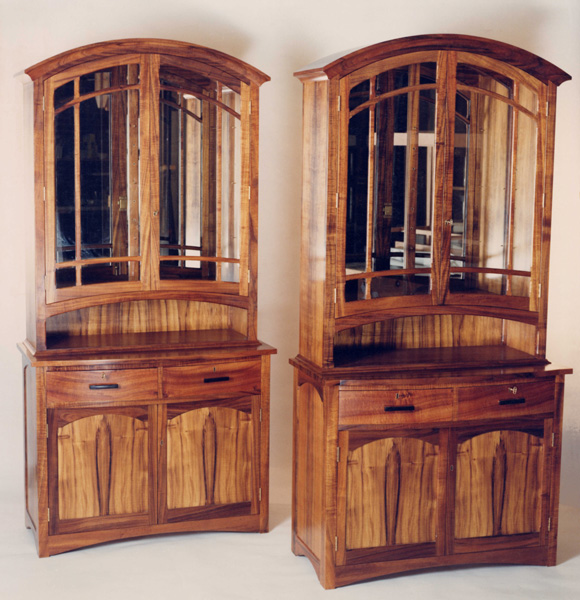
These cupboards flank an entry corridor into a light-filled, octagonal dining room. They are made of solid curly koa wood, a rare Hawaiian wood that is increasingly difficult to obtain at any price. The wood has striking grain pattern and color, seen in the dramatic bookmatched panels of the lower cases.
The overall design emphasized clarity and continuity in the curved lines and carved molding of the bonnet top. The contours of the upper doors follow this gentle curve, as does the mullions, lower apron, and frame and panel doors. In addition, each case features two drawers with ebony pulls, a recessed shelf, and keyed locks on all drawers and cabinets. The mirrored backs of the upper cases reflect the elegant framing of the curved mullions, and the glowing koa cases themselves, as they stand opposite in recessed niches.
More images
This design is part of an Art Nouveau dining room suite, and is rooted in several earlier sketches that I had made for other commissions. It was adapted and refined for a particular setting in the room, and reflects the scale, materials, and curving lines of other matching pieces in the large, open concept living-dining space.
The cornice and base molding, drawer and cabinet handles, and corner brackets are all hand-carved from solid wood. This and other pieces in the suite are built from carefully selected and cut curly maple, with contrasting black walnut handles and solid brass hardware.
More images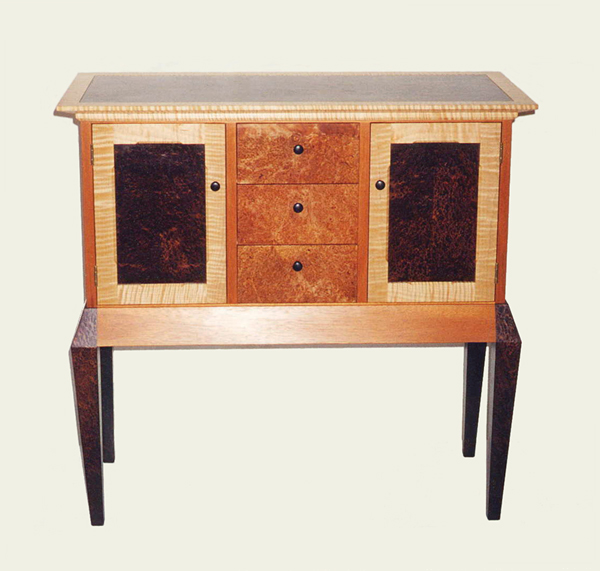
I have been fortunate that one of my friends from childhood has also pursued a successful career as an independent artist/craftsman, we check in periodically on our unique perspectives on the art world. He is a glass blower, and owns and operates the Dane Gallery in Nantucket, where he displays his creations and that of other famous glass artisans, such as Dale Chilhuly.
On this particular occasion, he asked that I build him a cellarette, which is a cabinet for fine liquors and accouterments. He had created a magnificent line of stemware, taking off from the colored glass rods and designs of Murano Glassworks in Italy. He wanted to collaborate on a special selection for his most esteemed clients – a complete set of stemware with its own custom display case.
I was happy to engage in such a fun project, and proceeded to find and use many unique species of wood in building this case, perhaps in emulation of the multicolored glass items that would be on display.
The woods used included redwood and curly maple burls, South American mahogany and curly maple. Robert Dane also created all the unique glass knobs used on the case.
More images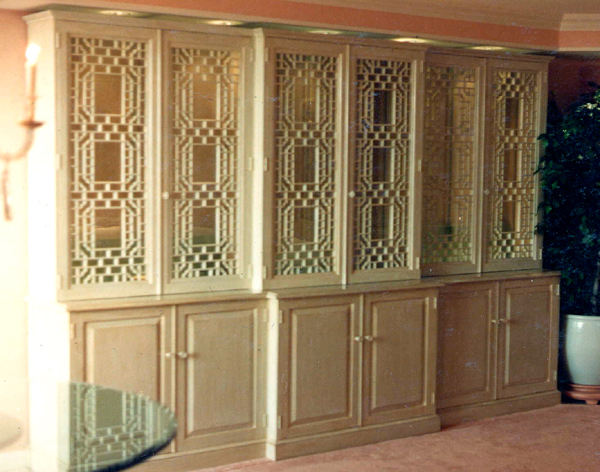
As I have indicated elsewhere, in the years I worked in Hawaii, clients would approach me with antique Asian carvings that they wished to incorporate into a well-made piece of contemporary furniture. On these occasions, I created a style that fused Asian and Western components. I am still doing that today, although I now carve the Asian motifs myself, as in the Buddhist Landscape Bed and the Lotus Credenza of 2010-2011.
In this piece, the client had 6 fretwork screens, which had been hand-made at great effort by an unknown artisan. I incorporated these screens as openwork panels in the doors of the upper cases of a step-back cabinet of basic frame-and-panel construction.
More images
In the 1970s and 1980s, the Salamandre Glass Gallery and Showroom In Portsmouth, New Hampshire provided me with the opportunity to display my own design sense in a very public forum. Although these artisans were not able to pay much, they allowed me to express my affinity for the Art Nouveau period – which was also renowned for such famous glass artists as Emile Galle and Louis Comfort Tiffany.
This secretary was commissioned by one of my early patrons, who saw my work in Portsmouth and wanted unique furnishings for his residence in rural New Hampshire. He needed a very serviceable desk with innumerable drawers and pigeonholes for his paperwork, and ‘secret’ locked compartments for valuables.
When closed, this secretary desk features 6 drawers flanking a kneehole area with a locked compartment in the recess. A full drawer spans the front, and the slant-top, drop front desk sits above that, with pull-out supports. The upper case is framed in cherry with black walnut panels, with a carved black walnut crown and cherry pediment rising above. The entire upper case is carved in the undulating art nouveau lines that distinguished the Salamandre Glass cases, and the custom-designed and cast brass hardware follows this curvature.
When opened, the desk and upper case reveal a warren of nested spaces and compartments, some with tiny doors, some with locks, and some with little drawers. This ‘workspace’ allowed for multi-tasking, and promoted organization for a businessman who traveled extensively.
More images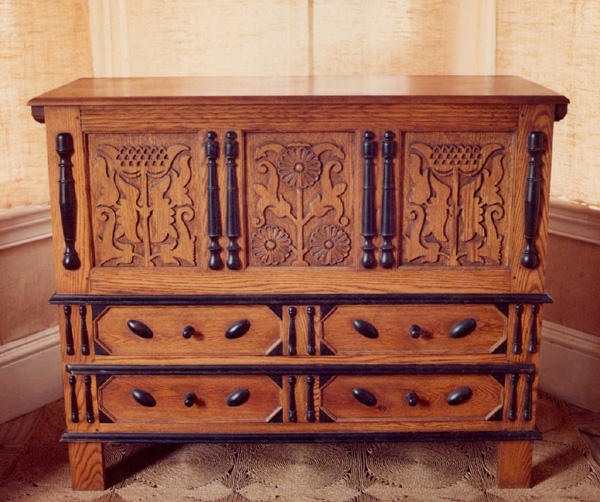
This solid oak blanket chest is modeled after the classic American folk Hadley Chests of the Connecticut River Valley. This classic case features two full-length drawers below with the top lifting to reveal a large storage box for blankets and woolens.
The façade of the case divides into three frame-and-panel sections above the drawers, with split, ebonized turnings detailing the vertical framing of the upper chest. Smaller ebonized turnings highlight the vertical frames of the lower drawers, while split eggs, ebonized knobs and corner blocks define the drawers.
The character of the chest is derived from the highly stylized, ‘folk’ carving of sunflowers on the upper chest. Three front-facing flowers define the center panel, while single plants fill the flanking panels. While the carving is essentially on two planes it is fairly deep, allowing for shadows to delineate the outline and recesses of the design.
More images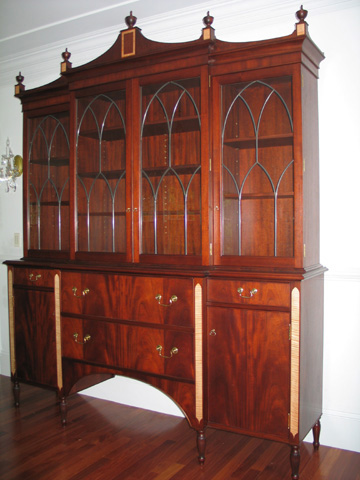
This large stepback case was made to complement a dining room with seating for 20 guests. As it was designed to house the china, silver and stemware for the service, the proportions grew to almost 7 feet in length, and 7 1/2 foot in overall height.
The overall design retains the classic elements, a three-section lower case with drawers and panel doors, and a four-section upper case with graceful lead-and-glass mullioned doors. The formal pediment features inlaid woods and turned mahogany finials. The central section of the case projects forward of the side sections, with a molded shelf dividing the upper and lower cases following the perimeter. The lower case is distinguished by 4 curly maple bands inlaid in the vertical framing, which accentuates the turned legs and adds contrast to the crotch mahogany panels. All drawers feature period brass bales.
More images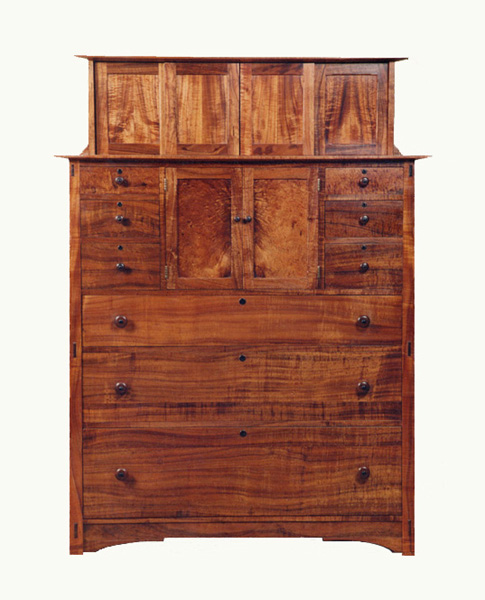
In the years that I lived and worked in Hawaii, I was able to acquire a supply of curly koa wood before it became rare, and even more expensive. The wood itself demands attention, and overshadows delicate carving and subtle variation, and this is especially true of curly koa.
I favored the simple lines of the Arts and Crafts style, to allow the richness of the wood grain to present itself. This large case contains a faux drawer front which drops down and pulls out to reveal a desk area with pairs of small drawers suspended on either side of the interior case. Below this desk are two graduated drawers, above the desk area double doors paneled in koa burl open to reveal a large storage area. This central section is flanked by three graduated drawers on each side. All drawers and doors have hand turned milo and rosewood knobs and key escutcheons as their sole ornament.
The upper case is detachable, and is modeled on the Japanese tansu with sliding frame-and-panel doors. The end panels are cut out in a tear-drop design, to allow ventilation for musical equipment.
More images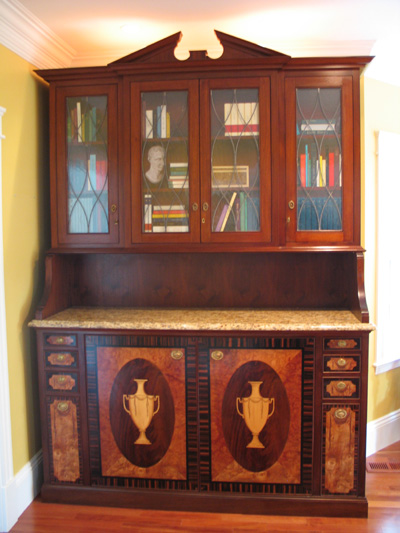
As clients begin to realize the potential of custom furniture design, they open their minds to a range of possibilities never before seen or imagined. This couple had previously ordered a complete dining room and media center, and had now come to a small adjoining room without definition. They realized that they needed and wanted a ‘bar’ for entertaining, but didn’t wish it to be a focus for their home or their children.
The resulting 'bookcase' would seem like a perfectly normal, and formal, focus of this small room. However, a considerable amount of faux painting – of the books, the Grecian urns, the bust of Caesar – covers this modified stepback cupboard, in addition to extensive marquetry. When the locks are opened, the interior reveals an ice maker and refrigerator behind the Grecian urns, copper-shielded ice bins behind the narrow lower doors, and liquor bottles and stemware behind the reverse painted books. The carefully veneered drawers of the lower case hold bottle openers and bar tools, while the untraditional and impregnable granite shelf provides a perfectly clean bar top, every time.
More images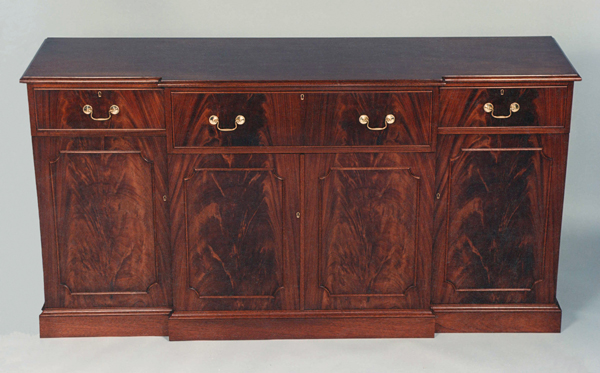
In the seven years that I ran a Custom Furniture shop in downtown Honolulu, I gained a reputation for my specialized training and ability to replicate European antiques. This was an unusual skill in the islands, and I attracted the attention of several antiques dealers, whose clients could not find authentic European antiques in that marketplace.
I was asked to create this period credenza for a family that had found success in the islands, but remained true to their cultural roots. The case is made with solid mahogany and a lumber core substrate, which was then completely veneered with select crotch mahogany flitches. I was able to apply the veneers so that the grain ran from the base of the cabinet doors and across the drawer fronts, providing a beautiful and continuous figure.
More images
In the late 1970s, I was asked to design display cases for a new art glass gallery opening in Portsmouth, New Hampshire. This small, coastal village one hour north of Boston had been a seaport for all of its existence, but was now fast becoming a center for art and creativity. The Art Nouveau display cases that I designed and built for this gallery launched my career, and my signature style.
One client saw these display cases and wanted a similar effect for bookcases in his own residence. Since it was a typical residence, the dimensions would be scaled down, and the individual sections would be more manageable. As in the original Art Nouveau case for Salamandre Glass, the lines of the design sweep across all three sections, unifying the whole composition vertically as well as horizontally. In these bookcases, we were able to design and cast custom hardware that unifies the lower doors and drawers.
The hand-carving on these cherry wood cabinets was much more developed than on the commercial piece. I was able to create a 3-dimensional cornice across the crest and around the sides of the three sections, matched by a similar treatment at the base of the cases. The rolled scroll appears in this carving, which has become a recurring motif in my work. Similarly, the sweeping, Art Nouveau line of the brace in the upper cases has appeared in varying forms across decades of my work.
More images